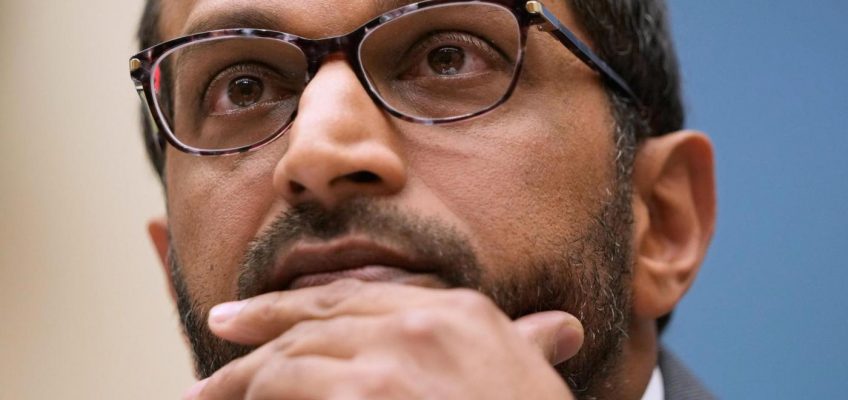By ERIC TUCKER and ALANNA DURKIN RICHER, Associated Press
WASHINGTON (AP) — FBI Director Kash Patel defended the Trump administration’s handling of the Jeffrey Epstein files Wednesday as he returned to Capitol Hill for a second day to face intense questioning from Democrats over his promises of transparency surrounding the wealthy financier’s criminal case.
The political blowback over the Trump administration’s decision in July not to publicly release more investigative files from Epstein’s case was at the center of Patel’s five-hour appearance before the House Judiciary Committee.
It followed an at-times raucous hearing before the Senate Judiciary Committee on Tuesday during which Democrats focused their attention on their criticism that Patel has politicized the bureau and turned it into a weapon against Trump’s perceived enemies.
Here’s a look at some key takeaways from Wednesday’s hearing:
FBI Director Kash Patel is sworn in as he appears before the House Judiciary Committee, on Capitol Hill in Washington, Wednesday, Sept. 17, 2025. (AP Photo/Mark Schiefelbein)
Tense moments surrounding the Epstein files
Some of the most explosive exchanges centered around the Justice Department’s handling of files related to the Epstein sex trafficking investigation as well as the FBI director’s past comments that raised conservatives’ hopes that the Trump administration would unearth new bombshells.
The top Democrat on the committee, Rep. Jamie Raskin of Maryland, played a clip from a 2023 interview in which Patel said that the FBI had Epstein’s “black book” with client names. After a lengthy review, the Justice Department in July said there was no evidence a so-called “client list” existed and it would not be publicly releasing any more files in its possession.
“How did you go from being a crusader for accountability and transparency for the Epstein files to being a part of the conspiracy and cover up?” Raskin said.
In another heated moment, Democratic Rep. Eric Swalwell of California peppered Patel with questions about whether he told Attorney General Pam Bondi that Trump’s name was included in the Epstein files.
When Patel didn’t immediately answer, Swalwell asked again more slowly, prompting Patel to snap back: “Why don’t you try to spell it out if you’re going to mock me? Use the alphabet: A, B, C, D, E, F.”
The FBI director repeatedly defended his handling of the files and insisted the FBI had released everything that it was “legally allowed” to. He pointed to judges’ rulings denying Justice Department requests to unseal grand jury transcripts in the case. Those rulings, however, don’t bar the Justice Department from releasing other investigative files related to the case.
Rep. Pramila Jayapal, D-Wash., speaks with FBI Director Kash Patel as he appears before the House Judiciary Committee, on Capitol Hill in Washington, Wednesday, Sept. 17, 2025. (AP Photo/Mark Schiefelbein)
FBI may look into Epstein birthday letter signature
Patel signaled that the FBI would investigate Trump’s claim that a sexually suggestive letter to Epstein purportedly carrying the president’s signature was forged. The letter was released by Democrats on the House Oversight Committee earlier this month after being handed over by the Epstein estate.
Trump has denied writing the letter bearing his name and what appears to be his signature includes text framed by a hand-drawn outline of a curvaceous woman. The president and the White House have repeatedly said it’s not his signature. The letter was included in a book prepared for Epstein’s 50th birthday in 2003.
The FBI director’s comment came in a line of questioning from Democrat Rep. Jared Moskowitz, who pushed Patel to say whether he would be “opening up an investigation into the Epstein estate for putting out a fake document.”
Patel initially responded: “On what basis?” But when Moskowitz asked again, Patel responded: “Sure, I’ll do it.” It’s not clear, however, whether the FBI would formally open an investigation and what such a probe would look like.
Committee Ranking Member Rep. Jamie Raskin, D-Md., speaks as FBI Director Kash Patel appears before the House Judiciary Committee, on Capitol Hill in Washington, Wednesday, Sept. 17, 2025.† (AP Photo/Mark Schiefelbein)
‘You have been a disgrace to the American people’
As was the case with Patel’s appearance one day earlier before the Senate Judiciary Committee, Wednesday’s hearing featured fiery — and, in at least one instance, expletive-marked — exchanges with Democrats.
That includes a shouting match with Swalwell, who said that a federal judge in New York had called “(expletive)” on the Justice Department by rejecting a request to unseal grand jury testimony in the cases against Epstein and his former girlfriend, Ghislaine Maxwell.
Patel repeated that expletive back to him when Swalwell asked him whether he would recuse from any investigations or adverse actions into any of the people, like himself, who were singled out as “members of the Executive Branch Deep State” in a book that Patel wrote before he became director earlier this year.
“I’m going to borrow your terminology and call (expletive) on your entire career,” Patel angrily shouted. “You have been a disgrace to the American people.”
Rep. Thomas Massie, R-Ky., speaks as FBI Director Kash Patel appears before the House Judiciary Committee, on Capitol Hill in Washington, Wednesday, Sept. 17, 2025. (AP Photo/Mark Schiefelbein)
Praise from a Democrat on crime
Trump was roundly supported, as expected, by Republicans but picked up praise during a deeply polarized political climate from Democratic Rep. Steve Cohen of Tennessee for the FBI’s participation in a law enforcement surge in Memphis called Operation Viper.
Trump on Monday announced with Republican Tennessee Gov. Bill Lee that National Guard troops would be deployed to the city to combat crime and join a special task force in the city comprised of officials from various federal agencies, including the FBI and DEA.
Lee has said the goal was to “accelerate the positive momentum of Operation Viper,” a federal crime-fighting mission in Memphis.
“You did a good job. The police director and the mayor have told me that has been helpful, the FBI working with the police,” Cohen said. “They know Miranda rights. They know how to do policing, and they do a good job working with the police.”
The White House posted on social media that the Memphis total crime rate was higher than the national average and suggested that it had increased since last year, bucking national trends. That’s despite Memphis police recently reporting decreases across every major crime category in the first eight months of 2025 compared to the same period in previous years. Overall crime hit a 25-year low, while murder hit a six-year low, police said.
“We’ve got some crime, but it’s not a troubled city. We’re not troubled,” Cohen said.
Republican leaders reject Democratic health care demands for bill to avoid shutdown
Trump, ICE target police in Chicago, other cities for recruitment in NFL ad
National Academy of Sciences rebuffs Trump EPA’s effort to undo regulations fighting climate change
Trump’s call to end mail-in voting creates a dilemma for GOP candidates who benefit from it
Obama says the US is at ‘an inflection point’ after Kirk’s killing and Trump has divided the country
‘Russia, Russia, Russia’ became a notable moment
Republicans focused attention on one of Trump’s chief grievances, the long-concluded federal investigation into ties between Russia and his 2016 presidential campaign.
Trump has derided the investigation as a “hoax,” “witch hunt” and “Russia, Russia, Russia,” and Patel on Wednesday said the fact that it was launched at all was a “massive scandal.”
The investigation did not establish criminal collusion between Russia and the Trump campaign, but multiple government reviews — including reports from the Justice Department inspector general and former special counsel Robert Mueller — found that the investigation had been opened for a legitimate purpose and that Russia interfered in sweeping fashion in that year’s election.
Patel confirmed to lawmakers that the FBI was investigating different aspects of the Trump-Russia investigation, including leaks to the news media, the discovery of documents from the probe that were found in so-called “burn bags” inside FBI headquarters and the production of an intelligence community assessment that was published in January 2017 and that documented Russian interference.
It is not clear whether any of these inquiries will produce charges or what crimes agents and prosecutors think may have been committed, if either.
Asked during the hearing if there was “more to be done to uncover the depths and origins of the Russia collusion hoax?”
“There is,” Patel replied, “and we’re doing it.”



